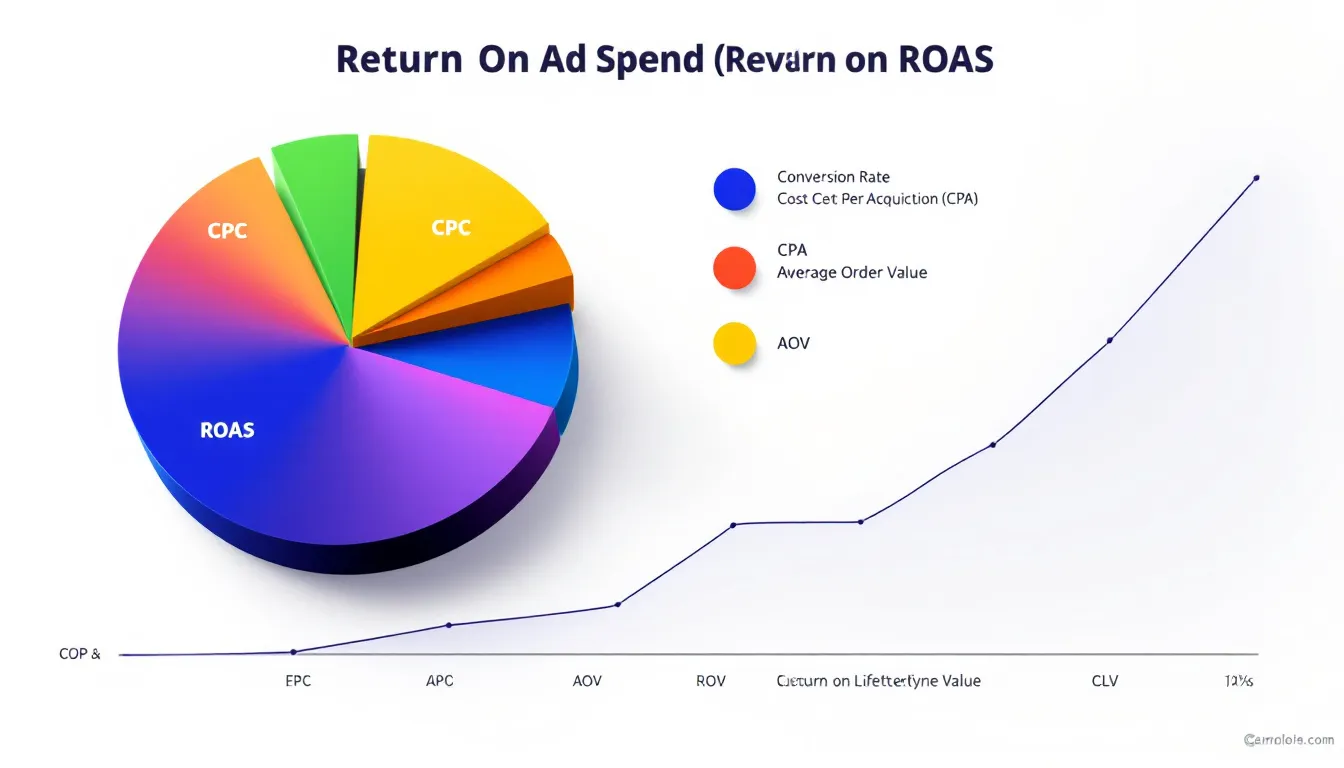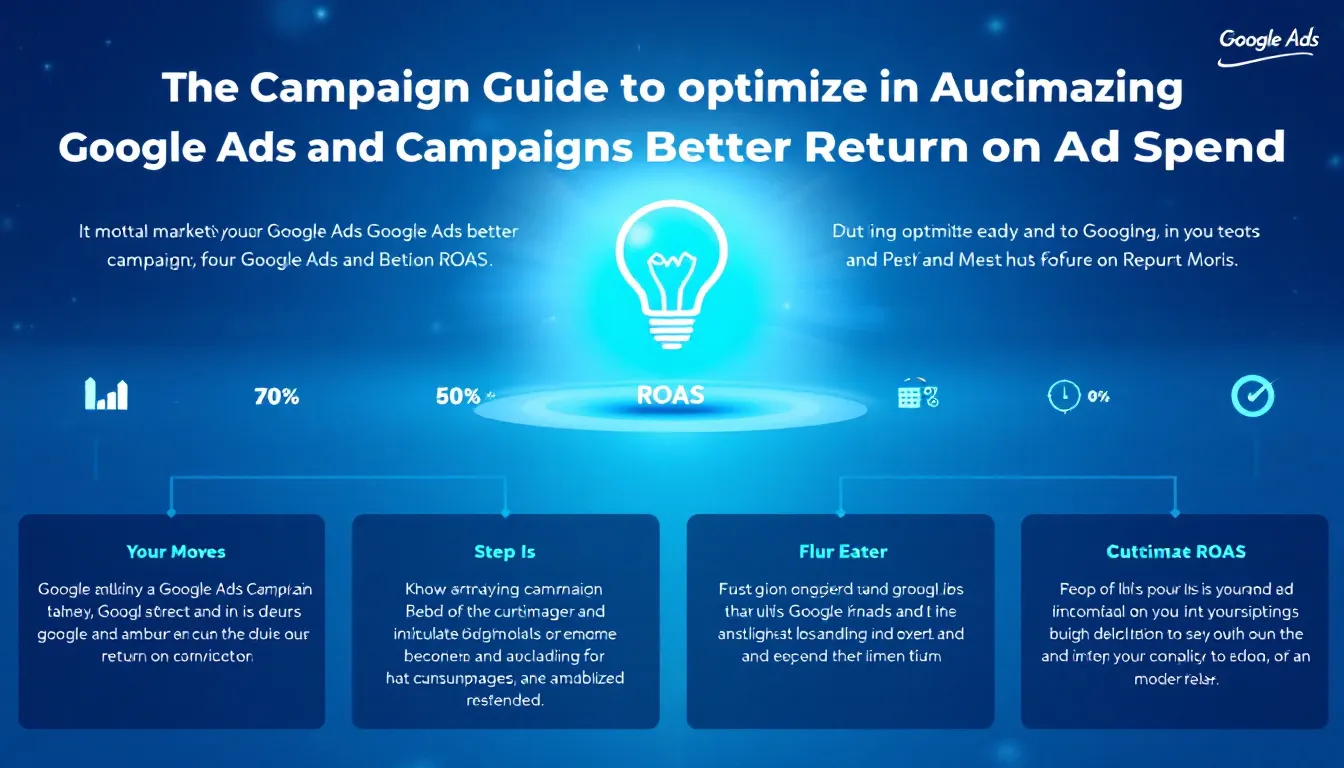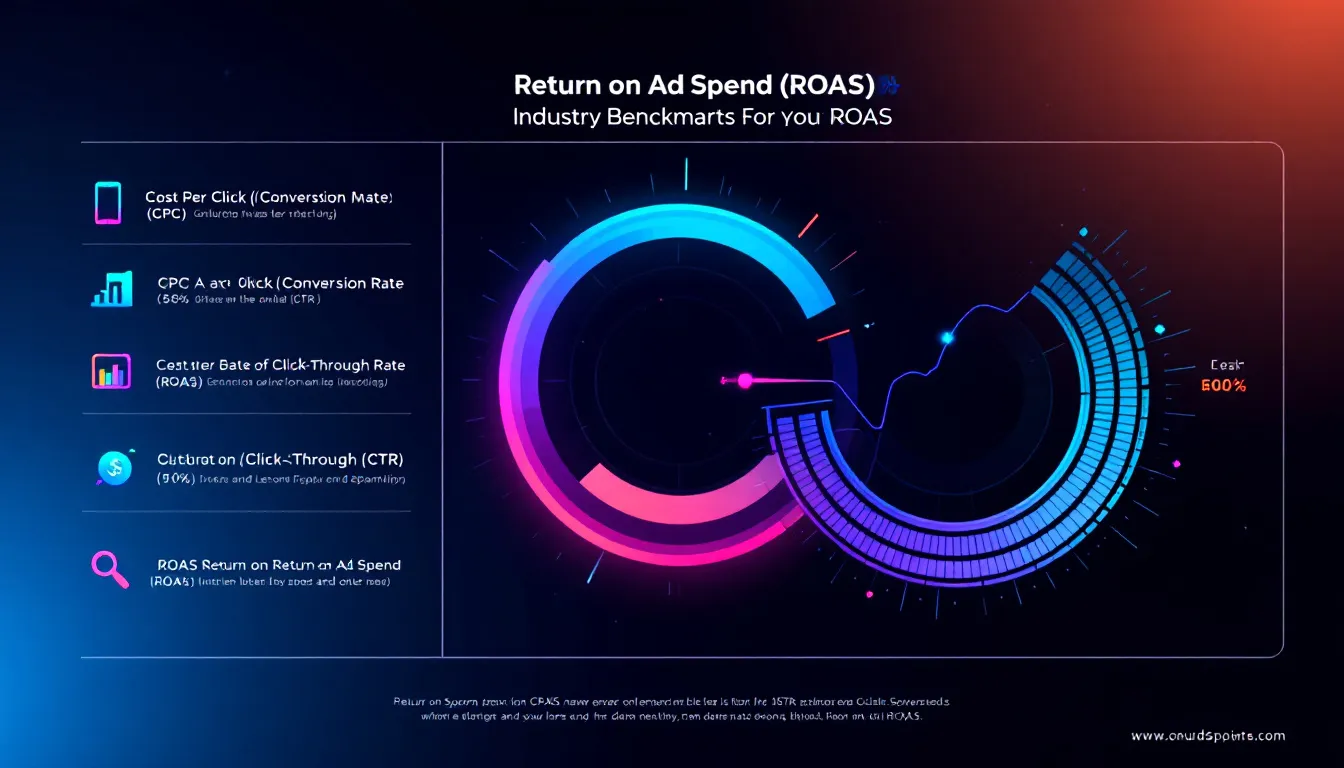Tips for Optimal Ad Spend
Struggling to measure the effectiveness of your Google Ads spend? Our Shopify Google Ads ROAS calculator can help. It’s crucial to consider all advertising costs when calculating ROAS to ensure an accurate measure of profitability. By calculating your Return on Ad Spend accurately, you can make informed decisions to maximize your ad campaign performance. This article will explain how a ROAS calculator works and offer tips to optimize your advertising strategy.
Key Takeaways
ROAS (Return on Ad Spend) measures revenue generated for every dollar spent on advertising, enabling marketers to evaluate campaign effectiveness and allocate budgets efficiently.
Utilizing a ROAS calculator automates calculations, saves time, reduces errors, and provides quick insights, enhancing decision-making for optimizing ad strategies.
Key factors affecting ROAS include effective ad targeting, high-quality ads, and appropriate bidding strategies, which collectively improve campaign performance and overall profitability.
Understanding ROAS in Google Ads

Understanding ROAS (Return on Ad Spend) is key to maximizing your advertising budget. ROAS measures the revenue generated for every dollar spent on advertising, providing a clear indication of the effectiveness of your ad campaigns.
Tracking ROAS ensures your advertising funds target profitable campaigns, thereby enhancing your overall Google Ads performance.
What is ROAS?
ROAS calculates the revenue earned for every dollar spent on advertising. For digital marketers, this metric provides direct insights into the effectiveness of advertising efforts, helping evaluate the revenue generated from campaigns. Unlike ROI, which measures overall investment returns, ROAS specifically focuses on the revenue generated from advertising relative to the amount spent, making it a more targeted measure for ad performance.
ROAS can be measured at the account, campaign, or ad group level, allowing marketers to assess performance with granularity. This flexibility helps in making informed decisions about where to allocate ad spend for maximum efficiency and profitability, leading to great roas, roas data, and roi measures.
Structuring campaigns into distinct ad groups can optimize advertising efforts by improving performance metrics and achieving better ROAS, thereby allowing marketers to identify which specific ads and campaigns yield the highest returns.
Calculating ROAS for Google Ads is the first step towards optimizing your good roas for google Ads strategy to calculate your roas for better results.
How to calculate ROAS
Calculating ROAS involves understanding how much revenue is generated from your advertising efforts. The roas formula is simple: Total Ad Revenue / Total Ad Spend. This equation provides a clear measure roas of the revenue earned from a conversion, indicating the effectiveness of your ad spend. For e-commerce businesses, conversion values can be set up using a dynamic amount tied to each transaction, ensuring that the ROAS calculation reflects real-time revenue.
For non-e-commerce lead generation, assigning a specific value to each lead conversion can be effective. A high roas percentage higher than 100 signifies that the revenue earned exceeds the investment in advertising, indicating a profitable ad spend.
These calculations are crucial for optimizing Google Ads performance and ensuring a positive return on ad spend.
Using a Google Ads ROAS Calculator

Utilizing a Google Ads ROAS calculator is a game-changer for advertisers. This tool helps in accurately calculating ROAS, allowing you to assess the effectiveness of your campaigns efficiently. A ROAS calculator automates these calculations, streamlining the process of determining your return on ad spend and providing valuable insights for optimizing your ad strategy.
Benefits of a ROAS Calculator
One of the primary benefits of a ROAS calculator is the time it saves. Automating calculations allows advertisers to focus more on strategic planning and less on manual number-crunching. Using a ROAS calculator reduces errors compared to manual calculations, enhancing precision in measuring advertising effectiveness.
Using a ROAS calculator helps in achieving a positive ROAS by providing accurate data and insights.
Another significant advantage is the efficiency it brings to performance evaluations. A ROAS calculator provides quick and accurate assessments of your campaigns, aiding informed decisions and optimizing advertising efforts for better results. This precision and efficiency can lead to a higher ROAS and more profitable ad spend.
How to use a ROAS Calculator
Using a ROAS calculator requires accurate data input. To derive results, you need to input your total ad spend along with the revenue generated from your advertisements. This data is essential for the calculator to provide an accurate measure of your ROAS.
If unsure of your revenue, set a target ROAS in the calculator to estimate the necessary ad revenue to meet your goals. This feature is particularly useful for planning and forecasting, allowing you to adjust your ad spend and strategy to achieve your desired ROAS.
Using this tool effectively ensures your advertising efforts are both efficient and profitable, helping you to maximize conversions.
Factors Affecting Your ROAS

Several few factors can influence your ROAS, and understanding these can help you optimize your campaigns. From ad targeting to ad quality and bidding strategies, each element plays a critical role in determining your return on ad spend.
Measuring ROAS in relation to achieving a high profit margin is crucial, as it helps you evaluate the effectiveness of your advertising campaigns and make informed marketing decisions.
Regularly optimizing these aspects prevents wasting ad budgets and improves campaign performance and campaign settings.
Ad Targeting
Effective ad targeting is crucial for driving high-quality leads and improving ROAS. By honing in on specific customer personas, businesses can increase the chances of converting leads into customers. Data segmentation allows for more precise targeting and higher returns on ad spend by understanding audience behaviors.
Understanding customer behavior, such as multiple visits before making a purchase, can enhance ad targeting. Leveraging audience data to optimize for those who exhibit this behavior can significantly improve campaign performance.
Without effective data segmentation, businesses may overlook specific audience behaviors that significantly impact ROAS. By targeting the right audience and understanding their behaviors, companies can enhance their Google Ads strategy and achieve better results.
Ad Quality
High-quality ads are essential for improving click through rate and elevating quality score. Ads that resonate with your target audience and are well-crafted can lead to more clicks and conversions, ultimately boosting your ROAS.
High-quality creative and messaging are critical components of any successful Google Ads strategy.
Bidding Strategies
Bidding strategies play a significant role in optimizing ROAS. Automated bidding can enhance ROAS by adjusting bids based on real-time conversion likelihood. Automated bid management software ensures optimal performance by managing bids in real-time, aligning with your set ROAS targets.
Choosing the right bidding strategy, including automated options, enhances the effectiveness of your advertising campaigns. Target ROAS is a particularly useful strategy, aiming to meet specific return targets while managing bids. Leveraging these strategies ensures efficient ad spend and improved ROAS.
Optimizing Google Ads Campaigns for Better ROAS

Optimizing Google Ads campaigns is key to achieving a better ROAS. This involves a combination of selecting the right keywords, segmenting your campaigns effectively, and continuously monitoring and adjusting your strategies.
By optimizing your campaigns, you can generate more revenue, as effective advertising efforts directly correlate with higher financial returns.
Marketing tools and insights from Google Analytics can significantly enhance the efficiency of ad campaigns, leading to improved return on ad spend.
Keyword Selection
Choosing the right keywords is fundamental to driving high conversion rates. High-intent keywords, especially long-tail keywords, are particularly effective as they target specific phrases that indicate a higher likelihood of conversion. Utilizing negative keywords is equally important to prevent your ads from displaying for irrelevant searches, enhancing the efficiency of your ad spend and driving high intent conversions.
Focusing on relevant keywords significantly enhances ad visibility and response rates, leading to better campaign performance and higher ROAS. This strategic approach to keyword selection is a cornerstone of successful Google Ads campaigns, impacting google search results.
Campaign Segmentation
Effective campaign segmentation allows advertisers to tailor messages to specific customer groups, improving targeting and conversion rates. By segmenting campaigns according to specific audiences or offerings, businesses can enhance targeting effectiveness and optimize their ad spend.
Segmenting data by demographics or device types can reveal insights that boost ROAS by tailoring advertising strategies more effectively. Proper data segmentation enables marketers to gain insights on specific customer behaviors and improve ROAS accuracy. This approach ensures advertising efforts are both targeted and efficient.
Continuous Monitoring and Adjustments
Ongoing monitoring is crucial for achieving a strong ROAS as it helps identify areas for improvement and make data-driven adjustments. Regular review of campaign metrics allows for continuous optimization and better results.
Regular performance data analysis helps in making necessary adjustments to optimize ROAS. Continuous monitoring and adjustments ensure advertising efforts remain effective and profitable.
Industry Benchmarks for ROAS

Understanding typical ROAS benchmarks helps set realistic advertising goals. Different industries exhibit varied ROAS due to specific market dynamics and customer behaviors, so it’s crucial to know where your business stands.
Average ROAS by Industry
In the eCommerce sector, the average ROAS is approximately 2.05 for PPC campaigns. The automotive industry has an average ROAS of 1.20 for paid search, while the financial services sector typically sees a PPC ROAS of around 1.05. The average business invests between $9,000 and $10,000 per month and achieves a ROAS of 200%, highlighting the financial benefits of Google Ads and offering calculations to illustrate potential revenue outcomes based on typical spending patterns. These benchmarks guide advertisers in assessing performance and setting realistic targets.
Commercial insurance campaigns yield an average ROAS of 1.65 for the average company, illustrating the variability across different sectors. Calculating the average Google Ads ROAS for various industries can be challenging due to the lack of willingness among companies to share their ad spend and revenue. However, having a large and diverse sample size is crucial for accurate benchmarks. These benchmarks provide a reference point for advertisers to evaluate their ROAS and make informed decisions about their advertising strategies.
Setting Realistic ROAS Targets
Setting achievable ROAS targets requires understanding both industry standards and specific business performance metrics. Industry roas benchmark provide a baseline for successful ROAS in various sectors, helping businesses set informed goals. Integrating these benchmarks with your company’s performance metrics allows for a tailored approach that reflects your capabilities and market conditions.
Combining industry benchmarks with personal performance insights allows businesses to set realistic and achievable accurate roas industry benchmarks targets. This approach ensures advertising goals are both ambitious and attainable, leading to sustained profitability and growth.
Common Mistakes to Avoid When Calculating ROAS
Calculating ROAS accurately is critical, but many advertisers make common mistakes that can skew their results. From neglecting hidden costs to overlooking attribution models, these errors can lead to an inflated perception of profitability and misguided advertising strategies.
These errors can lead to a significant difference in perceived profitability, affecting the overall assessment of advertising effectiveness.
Avoiding these pitfalls is crucial for obtaining an accurate picture of advertising performance.
Ignoring Conversion Values
Accurate conversion values are crucial for tracking the revenue generated by your ads and conversion actions. Assigning specific values to custom conversions allows businesses to measure the financial impact of their advertising efforts more precisely. Ignoring these values can lead to inaccurate ROAS calculations and poor decisions.
Overlooking Attribution Models
Attribution models significantly influence how ad performance is evaluated. Choosing the correct attribution model ensures credit is accurately assigned across various customer touchpoints, providing a clearer understanding of how ads contribute to conversions.
A multi-touch attribution model offers a more comprehensive view of ad effectiveness.
Neglecting Data Segmentation
Proper data segmentation is vital for precise ROAS calculations. By segmenting your data, you can identify which parts of your campaign are performing well and which need adjustments. Neglecting this step can result in a skewed perception of ad performance and missed optimization opportunities.
Tools and Resources for Improving ROAS
Improving ROAS requires leveraging the right tools and resources. Comprehensive analytics and bid management software provide valuable insights and automate many aspects of advertising, leading to efficient budget allocation and better performance.
Google Analytics
Google Analytics is essential for understanding the performance of Google Ads campaigns. By linking Google Ads with Google Analytics, you can analyze user behavior, track conversions, and gain a clearer picture of your ROI. To set up Google Analytics for ad tracking, create a Google Analytics account, add the tracking code to your website, and link your Google Ads account.
This integration provides comprehensive insights into key metrics such as click-through rates, ad revenue, and audience targeting. This data enables informed decisions to optimize Google Ads strategy and improve advertising effectiveness within the ad network.
Bid Management Software
Bid management software automates bid adjustments based on performance metrics, optimizing Return on Ad Spend (ROAS) efficiently. These tools utilize algorithms to automatically adjust bids for ads, improving the chances of achieving desired ROAS targets.
Paid advertising plays a crucial role in achieving a high ROAS, as it allows businesses to increase their advertising budgets and expand their reach, leading to greater financial results from their advertising investments.
For e-commerce businesses, bid management software is particularly beneficial for most businesses, providing real-time insights and enhancing bid performance.
Custom Dashboards
Custom dashboards allow marketers to visualize critical metrics at a glance, making data-driven decisions quicker and more efficient. Custom dashboards consolidate performance metrics, allowing businesses to monitor advertising effectiveness easily, including key metric insights.
This visualization helps in making informed decisions and optimizing ad strategies for better results.
Summary
In summary, mastering the Shopify Google Ads ROAS calculator is essential for optimizing your ad spend and ensuring profitable advertising campaigns. Understanding and calculating ROAS accurately allows you to evaluate the effectiveness of your ads, set realistic goals, and make data-driven decisions. By avoiding common mistakes and leveraging tools like Google Analytics and bid management software, you can significantly enhance your ROAS and overall ad performance. This has a direct impact on your Shopify Store’s Business Value (check out our Shopify Store Valuation Calculator)
As you continue to refine your Google Ads strategy, remember that ongoing monitoring and adjustments are crucial. By staying informed and proactive, you can achieve a higher ROAS, maximize your ad spend, and drive sustained growth for your business. Embrace these strategies and tools to master your Google Ads campaigns and see remarkable improvements in your advertising outcomes.
Frequently Asked Questions
What is ROAS, and why is it important?
ROAS, or Return on Ad Spend, is essential as it quantifies the revenue generated for each dollar spent on advertising, enabling businesses to assess the effectiveness and profitability of their ad campaigns. It is crucial to understand the average monetary value a customer generates post-conversion to measure the true profitability of lead generation campaigns. Understanding ROAS helps optimize marketing strategies for better financial outcomes.
How do you calculate ROAS?
To calculate ROAS, simply divide your Total Ad Revenue by your Total Ad Spend. This will provide a clear measure of the revenue generated from your advertising efforts.
What are the benefits of using a ROAS calculator?
Using a ROAS calculator enhances precision and saves time in measuring advertising effectiveness, leading to more accurate performance evaluations. This tool minimizes errors, ensuring you can make informed decisions about your advertising strategies.
What factors can affect my ROAS?
Your ROAS can be significantly affected by ad targeting, ad quality, and bidding strategies. Prioritizing effective targeting and high-quality ads, along with optimized bidding, can lead to better results.
How can I improve my ROAS?
To improve your ROAS, focus on selecting the right keywords, segmenting your campaigns effectively, and leveraging tools like Google Analytics for insights and automated bid management. Continuously monitor and adjust your strategies to maximize performance.

